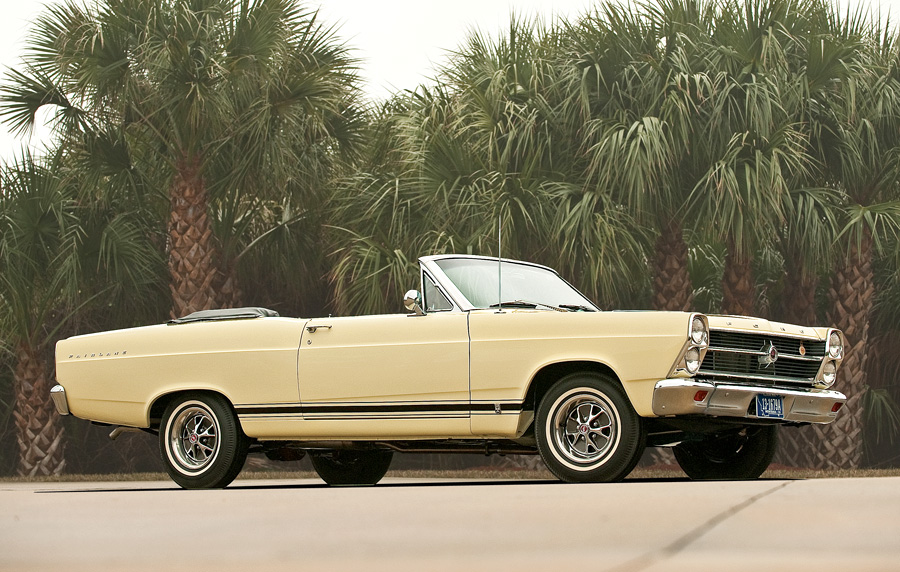- 390-ci, 335-hp S-code Thunderbird Special V8
- Sportshift automatic transmission
- One of 4,327 GTA convertibles in 1966
- Ground-up restoration on solid, original car
- Restoration utilized NOS parts
- AACA National First in Junior and Senior
- Appraised as “Condition 1” car
- Styled steel wheels
- Power top
- Buckets and console
- Visibility and courtesy light groups
SCM Analysis
Detailing
| Vehicle: | 1966 Ford Fairlane GTA convertible |
| Years Produced: | 1966–67 |
| Number Produced: | 4,327 (1966) |
| Original List Price: | $3,068 |
| SCM Valuation: | $35,200 |
| Tune Up Cost: | $150 |
| Chassis Number Location: | Tag on driver’s door |
| Engine Number Location: | Pad forward of passenger’s side cylinder head |
| Club Info: | Fairlane Club of America |
| Website: | http://www.fairlaneclubofamerica.com |
| Alternatives: | 1966–67 Pontiac GTO, 1966–67 Chevrolet Chevelle SS 396, 1966–67 Dodge Charger |
| Investment Grade: | C |
This car, Lot 539, sold for $62,700, including buyer’s premium, at Auctions America’s sale in Fort Lauderdale, FL, on April 1, 2017.
In 1966, Ford introduced the fifth-generation Fairlane. The updated model brought back the convertible option after Ford dropped it from the Fairlane lineup in 1959, and used stacked headlamps and just a hint of the coke-bottle silhouette that defined design at the time.
The factory-backed match race days were waning at this point, but big, streetable power was far from finished selling in the market. So as the track-dominating Thunderbolts left the scene, in came mid-size family cars with over 300 horsepower. They quickly became commonplace.
Ford’s attempt at capturing the burgeoning market, and taking on the popular Chevelle SS 396, was to stuff a 335-hp, 390-ci V8 into that redesigned Fairlane. The new cars became known as the GT and GTA S-codes. The Blue Oval sold 37,342 GT/GTA S-codes that first year, so they got something right.
Within the Fairlane lineup, the GT/GTA sat at the top, followed by the 500 XL, then 500 and finally the base models. The current market pricing bears this out as well, but more on that in a minute.
Looking legit
With every sale, but especially when we’re talking about more than credit-card money, verification and authentication are vital. Buyers need to know whether they’re actually buying the real deal.
Faking a 1966 Fairlane GTA is tough business. At least it’s much harder than just an engine swap with some decals added. For one, the S-code 390 was the only engine for 1966 Fairlane GTs, so any variance in the VIN (which Ford stamped in three locations — radiator core support and one on each of the inner fender wells) indicates things are not what they seem. And if there is a clutch pedal? Someone ordered the wrong emblems to fake the car, as in GTA, the A stands for “automatic” (conversely making the GTs manual-only cars from the factory).
This car’s authenticity is hardly questionable, however, with copious judging, copies of original paperwork and even a feature (and implicit blessing) in the Fairlane Club of America’s magazine.
A previous owner put the car through ground-up restoration from 1996 to 2000 using New Old Stock. That owner was supposedly looking for a solid, original Springtime Yellow-with-black-interior car. He found this one in Tallahassee, FL. After completion, he then showed it at Carlisle All-Ford Nationals invitational.
Oh so nice
This GTA is exceptionally well equipped, with power top, limited-slip differential and tinted glass, among other options. Seems like the only knock is a lack of disc brakes. Ford made front discs available for the later 1966 Fairlanes, and the option became standard for 1967 models.
Even the automatic isn’t necessarily a downer. Ford issued a press release in September 1965 touting the new Sportshift transmission “which offers complete manual selection of the three forward Cruise-O-Matic speeds by the driver… And, to put the frosting on the cake, manual shifting is quicker than with a comparable car equipped with a manual transmission.”
Given the manual-shift automatic feature’s ubiquity in today’s world — you can even do it in a Hyundai — it’s easy to forget that once upon a time, many automatics had “D” for drive and no individual lower-gear selections.
To me, this GTA is everything one would want in a muscle car. Maybe it lacks the street cred of a GTO, but the FE V8 pumps out the same rated horsepower as a ’66 389-powered GTO and wins in cubic-inch displacement. Where I should be going next is the incredible value of GTs versus GTOs, but this price brings that argument to its knees.
Top goes down, price goes up
These ’66 GTA convertibles rarely arrive at auction. By that measurement, it’s reasonable to wonder how many of the 4,327 GTA convertibles are still around. Granted, it’s likely more than the remaining, running 4-door sedans, but if it is more than half of the original number, I’d be surprised. In fact, this is the only one seen in the past two years according to ACC’s Premium Auction Database. Going back a little further, Mecum sold a GT convertible for $56,160 at their January 2015 Kissimmee sale (ACC# 6774646).
This is the most expensive 1966 Fairlane sold at auction since Twin Cities sold an R-code Fairlane 500 for $160,500 in June 2015 (ACC# 678852). Our subject car is also the 13th-highest-selling fifth-gen Fairlane ever sold at auction. As such, it’s difficult to argue it wasn’t well sold.
But what is it they say? Buy the best you can? I’d say the new owner did just that. So with that thought, I’d call this GTA drop-top both well bought and well sold.
(Introductory description courtesy of Auctions America.)
